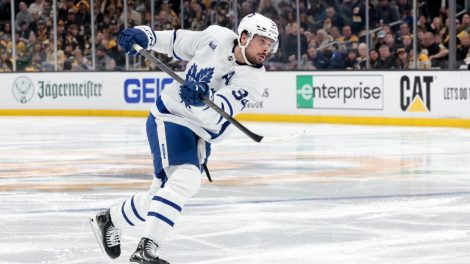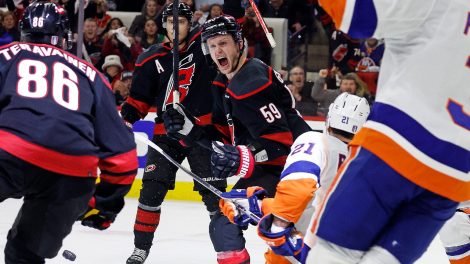The Edmonton Oilers have a unique opportunity this season, one they won’t ever get again.
Connor McDavid is the reigning NHL MVP, and thanks to cost-controlled entry-level contracts he’s easily the best bargain in the league for another season. The Edmonton Oilers are only on the hook for $3.775 million for his services. That figure jumps to $12.5 million in 2018-19, with the difference between those two figures representing roughly 12 per cent of the entire Oilers cap space.
That raise, while deserved, is going to make it more difficult to build a quality supporting cast around McDavid. That’s what makes 2017-18 so special: Edmonton can take that cap space and shore up its roster in ways it won’t be able to once its generational talent starts being paid like one.
McDavid’s contract is not the only reason for haste. Oilers GM Peter Chiarelli has some fine value contracts on the books right now, but the clock is rapidly winding down on all of them.
Edmonton has five significant restricted free agents to deal with next summer, all of whom are likely to receive raises. The club also needs to pay or replace pending unrestricted free agent Patrick Maroon, a clever trade acquisition by Chiarelli who scored 27 goals on a $1.5 million cap hit last season.
Money freed up when Mark Fayne’s contract expires and Lauri Korpikoski’s buyout runs its course will help, but won’t come close to covering the full tab. Additionally, the Oilers will need to have a plan to free up more money in place for the following summer, when starting goalie Cam Talbot and 2016 fourth overall pick Jesse Puljujarvi will need new deals.
| Significant expiring contracts, 2018 and 2019 | ||
|---|---|---|
| Player | Cap Hit | Expiry |
| Cam Talbot | $4,166,667 | UFA, 2019 |
| Ryan Strome | $2,500,000 | RFA, 2018 |
| Mark Letestu | $1,800,000 | UFA, 2018 |
| Patrick Maroon | $1,500,000 | UFA, 2018 |
| Anton Slepyshev | $925,000 | RFA, 2018 |
| Drake Caggiula | $925,000 | RFA, 2018 |
| Matt Benning | $925,000 | RFA, 2018 |
| Jesse Puljujarvi | $925,000 | RFA, 2019 |
| Darnell Nurse | $863,333 | RFA, 2018 |
The financial picture is going to get a lot more complicated in short order. Balanced against that reality is the age range of Edmonton’s most important players.
In last year’s playoffs, the Oilers’ three most-used forwards were 20, 21 and 24, respectively. Their top two defenders were 23 and 24. If we eliminate salary considerations from the equation, we’re talking about a team just entering its prime, and built to win over the long haul.
Chiarelli and his staff appear to be taking a hybrid approach to dealing with these conflicting truths, one which allows them to gun the engine if it looks warranted in the spring, but which doesn’t commit them to doing so earlier than that.
The summer plan Edmonton executed was not that of a contender. It didn’t bring in a replacement for injured top-four defenceman Andrej Sekera, and up front it downgraded from Jordan Eberle to Ryan Strome in exchange for cap space it doesn’t really need this season. Tinkering done further down the depth chart isn’t likely to significantly alter their fortunes.
One could reasonably describe that off-season as disappointing from a win-now perspective. Yet one could also make the argument that what the Oilers did was retain flexibility.
Edmonton enters 2017-18 with financial freedom. Cap Friendly currently projects the team to have a little more than $8.3 million in room, enough space for them to cover all of their entry-level bonuses. That figure doesn’t take into account the impact of Sekera starting the year on injured reserve, or the savings realized by burying Fayne’s deal.
[snippet ID = 3322139]
The Oilers are also rich in trade deadline assets. They have all of their own draft picks for the next three seasons, a prospect chart rich with defencemen, and four or five young NHL players who could be trade bait in the right deal. If the team looks like a contender come February, Chiarelli is in good position to bolster the roster.
The advantage to this approach is that it allows Edmonton to address whatever needs crop up early, or in the worst case scenario to save its resources for the next year. The disadvantage is that the trade deadline is the priciest point in the season to try and add talent.
Chiarelli knows this firsthand. In 2011, he loaded up the Bruins for a (successful) Cup run with a trio of big trades. It cost his team Blake Wheeler, Joe Colborne and three high draft picks, one of which turned into Rickard Rakell.
If Edmonton is in position to win a Cup this spring, it shouldn’t hesitate to run up the bill and take advantage of its unique cap situation. Winning is still going to be possible down the road, but will require both creativity and ruthlessness.
It will almost certainly also require McDavid and Leon Draisaitl to become the focal points of separate lines. Whatever hard choices the Oilers make, it’s going to be very difficult to win while spending 30 per cent of their cap space on two players who share the same line. There just won’t be enough money left over to build a credible second and third unit.
Conventional wisdom holds that Ryan Nugent-Hopkins will need to be a cap casualty in this scenario. That’s likely, though not automatic. Pittsburgh got away with three big forward contracts spaced over three different lines in 2015 thanks to a cheap defence and lots of low-price supporting forwards. It’s an approach that Edmonton could replicate to at least some extent, though it might require sacrificing Maroon or a veteran blueliner instead.
The Oilers don’t need to make those decisions now, though. This season the team can run three forward lines anchored by highly talented centres and backstopped by a veteran top-four on the blue line. It can afford to bring in a high-end rental or two to push for a Cup.
It should take advantage of these luxuries while it still can.
[relatedlinks]









